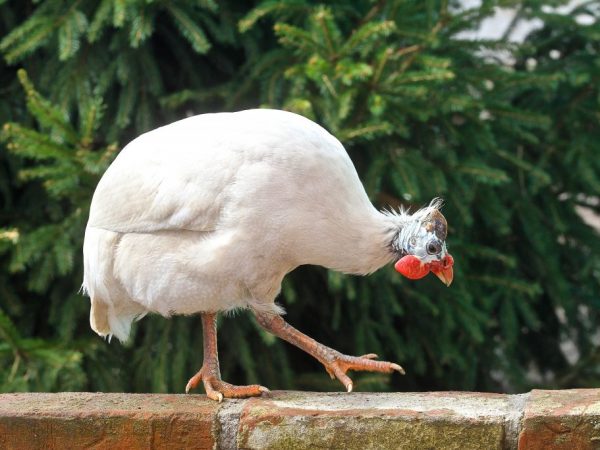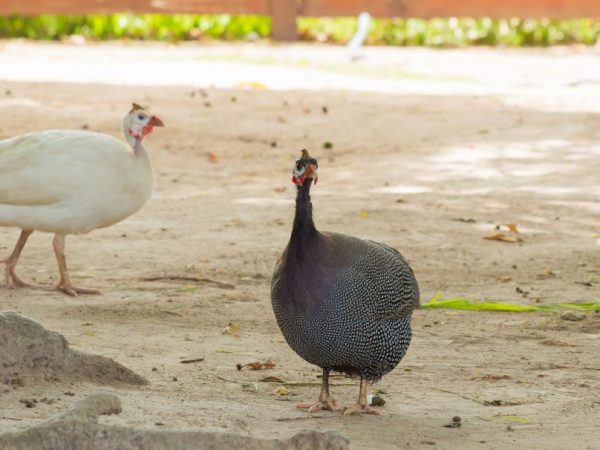What is the difference between a female and a male guinea fowl
Guinea fowls are a unique breed of birds, originally from Italy, famous all over the world, thanks to their undemanding, tasty, dietary meat and large, healthy eggs with strong shells, which extend the shelf life of products up to six months. Birds that have conquered the hearts of millions have become popular farm animals. In this regard, the question has become urgent for breeders and poultry farmers (especially beginners): How to distinguish a female from a male guinea fowl?

The difference between a female and a male guinea fowl
Distinctive features of the Caesar and Guinea fowl
Tsar's heterosexual birds are very similar to each other, so it is difficult to distinguish them by sex without experience. Experienced poultry breeders can determine the female by just looking at the photo, because they know the external features of the birds in question. Consider how females differ from males:
- The body weight of a guinea fowl differs from the weight of a caesar by approximately twenty percent and its body is larger. Important: the first five months from the day of hatching, the weight of the birds is approximately the same, so this method of comparison for almost six months is considered useless.
- You can also find out the sex of a bird by its beak (as in humans, a girl looks more graceful than a boy). In females, the beak is neat, not large, smoothly turning into the head. The skin on the base is red-orange in color, the nostrils are pressed (not puffed up). In the male, the front of the skull is more bumpy (there is a kind of growth). The beaks increase with age, become thicker and stand out strongly on the head. The base of the beak of the Caesars, in contrast to the guinea fowl, is covered with skin of a brighter red color, the nostrils are large, as if "swollen". Important: differences in the beak can be detected not earlier than when the birds reach the age of four, and sometimes even five months.
- Also, gender can be determined by the ridge on the head. But this is more difficult to do, since these differences in real life are not so clearly visible. However, if you are an attentive and experienced person, then this method of differentiation is for you. In the photo in the special literature, you can see that the ridge in males is larger than in females, located in a position bent back and slightly raised from the base of the head.
- The royal chicken has adornments at the bottom of its beak, which are called earrings. In females they are soft and small in size, in males they are larger and fleshy. Important: with age, the female earring begins to “coarse” and becomes similar to the “male” one, therefore, it becomes more difficult to distinguish maturing individuals by this feature every day.
- Another difference by which you can find out who is in front of you is the position of the head while walking. The female keeps her head and neck on a par - only vertically, while the males slightly tilt their head forward. It is worth noting: the Caesars' gait is proud, the tail is raised, as if they are pacing in front of their ladies to show all their beauty. At this moment, they look like a rooster that bypasses its possessions.
Poultry breeders give the simplest answer to the question of how to distinguish a male from a female guinea fowl - of course, which bird lays eggs is the girl. It is logical, but not always permissible (especially between clutches).
How to distinguish birds by voice characteristics

There is a crackling in the male's voice
Tsar's hens are noisy birds and loud enough. There is a subtle crackling in the voice of males. This is also a hallmark of the sex of the species of birds in question.
How to distinguish guinea fowls in the first days of life
It is believed that determining the sex of a feathered individual is impossible until at least three months have passed. This is a misconception, since the male guinea fowl from the female can be distinguished by the external genitals. How to determine the sex of a guinea fowl whose age has not yet exceeded three to four months of age? To do this, you will have to use a visual-tactile method. Instructions:
- Pick up the bird carefully.
- Pet the feathered, calm down.
- Move your hand in the direction from the abdomen to the cloaca and spread the feathers, especially between the legs.
- Reveal the presence of genital organs similar to tubercles (the female does not have such a sign).
- Feel free to conclude - "In the hands of a male."
Important: during the procedure, you need to exclude any sudden movements so as not to stress the bird.
Why gender determination is important
Identifying female or male is an advantage for the farmer, because once you've learned this, you will:
- Stop being bait for fraudulent sellers who want to portray a female for a male.
- You will be able to properly build a business for breeding unique, undemanding birds, creating the right sex ratio in the livestock. Since there is one male for five females, it is not difficult to calculate that for a flock of 20 female birds, only 4 male birds are needed.
Now you know that gender identification of guinea fowls is important for the farmer. After all, females are more valuable representatives of the species than males. We hope that this review will help you to correctly determine the gender of your ward birds.


